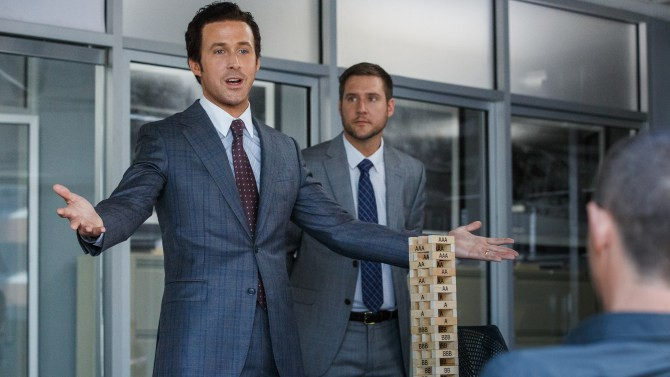8. Princess Mononoke
7. Chi-Raq
Unfortunately, it ended up being a disappointment in my eyes. Spike Lee’s latest feels less like a movie and more like a variety show. It’s disjointed, but not in a way that pulls together disparate perspectives in service of one theme or message. It’s not funny enough to be farce, not insightful enough to be satire, and too unfocused (and plain silly) to leave any strong statements in the minds of viewers about gun violence in America. It certainly has a lot to say, which it often imparts in rhymed verse that should appeal to lovers of Shakespeare and hip hop equally. However, much of its dialogue is too didactic to feel remotely authentic. Additionally, some Chicagoans have objected to Lee’s entire premise and his ability to understand the particular situation of the South Side. I can’t comment on that personally, but whenever I tried to pull a metaphorical meaning from Lee’s idea of a sex strike, I couldn’t unearth it — and from an interview that I saw Lee give on Colbert several months ago, I wonder if he really doesn’t have any bigger-picture intentions on that matter.
However, I did appreciate the frequent references to the institutional discrimination that exacerbates all the other problems that the film discusses. It was an interesting choice to have one of the only white characters in the film (a clergyman played by John Cusack) be the mouthpiece for many of these truths. Some might call it problematic, but I prefer to see it as Lee urging white viewers to listen up, expand their worldviews, and join this movement for peace.
Chi-Raq’s greatest good is that it reveals the megastar potential of its lead, Teyonah Parris. If Hollywood has any sense (and the jury’s still out on that one), it would offer her as many multi-dimensional and interesting roles as she could fit into her schedule.
You can watch Chi-Raq on Amazon Prime.
6. Melancholia
One of the features of this movie that might make it unpalatable for viewers is that it begins with an eight-minute overture of strange, apocalyptic images and thunderous classical music. I wouldn’t be surprised if most people backed out at some point during this experience, but I really do believe that it sets the stage for the rest of the film so well. The overture establishes a universe that is frightening and unsettling, fatalistic and epically awful. We quickly come to see that this is the perspective held by the film’s two main characters, two sisters named Justine (Kirsten Dunst) and Claire (Charlotte Gainsbourg), because of their struggles with mental illness. The camera allows us to look through these women’s eyes and see what they project onto each scene.
Part 1 of the film, entitled “Justine,” seems to be an allegory of living with depression; each character at Justine’s wedding stands in for a different (unhelpful and unsuccessful) way that someone might handle a friend or family member with depression. Dunst submits the best performance of any movie on this list (except for an actor in my #1 movie of the month). She puts on a face of grace and jubilance as would be expected of any new wife, but gradually allows the pain and anhedonia that her character experiences to claw its way to the surface and take over. Besides the fidgety camerawork that distracted me at certain points, I found this section of the film to be riveting.
Part 2, called “Claire,” was a bit harder to mine for meaning and a bit less interesting since the overture had hinted all along at how the story would conclude. Still, I loved how it began to incorporate more and more elements of a sci-fi disaster movie. (Some of its sky-gazing shots are more beautiful than anything in recent movies like Interstellar or The Martian that were actually set in space.) Also, its dramatic rendering of the anxiety that Justine’s sister experiences is an effective vehicle for director Lars von Trier’s message: this is how it feels. To live with this sickness is to fight against imagining the worst possible scenario at all times. It’s as drastic as believing that planets might literally collide.
You can watch Melancholia on Netflix.
5. The Big Short
4. Dope
The movie has plenty to say about issues of race and how they impact black identity and achievement, but these ideas never seem superfluous or grafted onto the main story. In general, Dope’s characters and settings feel true to life in 2016, but they’re usually confined to other forms of media (or not shown at all), so it’s exciting and refreshing to see them on center stage in a feature-length film. Shameik Moore is a natural in the leading role, and I’m really looking forward to see him in Netflix’s The Get Down later this year.
You can watch Dope on Netflix.
3. No Country For Old Men
After a lot of thought, I’ve come around to the idea that the Coen brotherswanted to unsettle me like this. It reminds me of something that one of my favorite TV critics, Andy Greenwald, has said about the first season of one of my favorite shows, The Leftovers — basically that he hated it at the forefront of his consciousness because it was asking him to deal with pretty frustrating and upsetting ideas underneath the surface. It’s hard to deal with the notions that life might be nasty, brutish, and short, or that the arc of the moral universe might not bend towards justice. But this movie asks us to, and I respect it for that.
Plus, I wouldn’t have been so mad about the last 20 minutes if the first 100 hadn’t been so engrossing. This movie exemplifies the best of Western/crime thrillers; it’s suspenseful, gritty, and shocking. Javier Bardem pulls off the nightmare-inducing psychopath quite well (even if I thought the whole coin thing was a bit gimmicky), and Josh Brolin perfectly displays a man who seems much more confident and capable than he actually is. The Academy wouldn’t normally choose a movie like this for Best Picture, but it did, and it’s great to see two of our best directors get recognition.
2. Burn After Reading
The Coens are masters at shifting back and forth between humor and horror, and their work in Burn After Reading is no exception. The movie leaves you with the troubling notion that something can so easily come out of nothing — that a simple set of misunderstandings can precipitate a total disaster. You’re also forced to wonder about our nation’s increasingly omnipresent security apparatus: how often does it defuse these disasters, and how often does it accidentally cause them?
You can watch Burn After Reading on HBO GO.
1. The Master
But The Master completely floored me. First of all, it’s beautiful. I don’t have much of a working knowledge of cinematography, but all I can say is that this film’s color palette is rich and evocative of its 1950s setting, and it (in addition to its otherworldly soundscapes) makes the movie a total joy to absorb. Secondly, Joaquin Phoenix, as a deeply troubled WWII veteran named Freddie Quell, gives a performance with more range, tension, and unexpectedness than anything I’ve seen in recent memory — certainly more than anything I’ve written about this month or in January. The role requires rage, violence, weirdness, instability, and vulnerability, but Phoenix gives freely and fully. He’s completely believable, and it’s impossible to look away. As for the plot, I’ve heard from others that they found it to be inscrutable or hard to follow. I will admit that events aren’t always laid out plainly, and we’re not always sure what certain lines of dialogue are meant to imply, but I would urge viewers to trust the filmmaker and let him take the lead.
After the end of the war, Quell undergoes a series of strange trials but eventually comes under the wing of a cult leader named Lancaster Dodd (Philip Seymour Hoffman), and their relationship is the main focus of the movie. The Master deals with a collection of visceral concepts, but nearly all of them return to one question: who deserves our devotion? It’s a film that begs for deep psychoanalysis, having so many ideas swirling throughout that relate to power and attraction, repression and self-medication, love and idolization, and belonging and fatherhood that I’d have to write a full thesis to feel like I’d finally exhausted the text (and I’m sure there are film majors out there who have done just that).
Because Phoenix’s performance captivated me so much, I think my interpretation of the movie was colored by Quell’s perspective, but you could focus on Dodd’s motivations or the motivations of Dodd’s wife, played by Amy Adams, and arrive in totally different places. I look forward to rewatching The Master a couple more times and pulling together these interpretations. I really do believe that the film deserves that type of close attention.
You can watch The Master on Netflix.








 RSS Feed
RSS Feed
